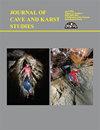Caecidotea burkensis, new species, a unique subterranean isopod from Burke’s Garden, with a synthesis of the biogeography and evolution of southwestern Virginia asellids
IF 0.5
4区 地球科学
Q4 GEOSCIENCES, MULTIDISCIPLINARY
引用次数: 0
Abstract
Caecidotea burkensis, a new species of subterranean asellid isopod, is described and illustrated from material collected from Lawson Cave, in Burke’s Garden, Tazewell County, Virginia. The type-locality in Burke’s Garden is located within the highest mountain basin in the southern Appalachians. Burke’s Garden is a unique, geologically isolated area encompassing one of the headwater streams of the New River basin. Phylogenetically, the isopod is a member of the forbesi Group, a clade comprised primarily of epigean species. The complex mountain valleys and coves of southwestern Virginia are an area of intense speciation among asellids that have produced a bizarre array of cavernicolous species belonging to groups of otherwise epigean isopods. In addition to a few subterranean species of the Caecidotea cannula and stygia Groups, the Lirceus hargeri Group possesses over a dozen species endemic to caves and springs in the region, mostly only now in the process of being discovered and described. With so much species richness, syntopy of two, or even three, asellid species is commonplace in caves and springs in southwestern Virginia.布尔肯山蛭形虫,新种,伯克花园中一种独特的地下等足类动物,综合了弗吉尼亚西南部asellids的生物地理学和进化
从弗吉尼亚州Tazewell县Burke 's Garden的Lawson洞穴收集的资料中描述和说明了一种新的地下类等足类动物——布尔肯氏Caecidotea burkensis。伯克花园的类型地点位于阿巴拉契亚山脉南部最高的山脉盆地内。伯克花园是一个独特的,地理上孤立的地区,包括新河流域的源头溪流之一。在系统发育上,等足类动物是forbesi类群的一员,forbesi类群是一个主要由表足类物种组成的分支。弗吉尼亚州西南部复杂的山谷和海湾是一个物种形成激烈的地区,在这些地区产生了一系列奇怪的洞穴状物种,这些物种属于其他上古等足类动物。除了Caecidotea cannula和stygia类群的一些地下物种外,licuceus hargeri类群还拥有该地区洞穴和泉水特有的十多种物种,其中大部分现在才被发现和描述。有如此丰富的物种,两种,甚至三种,在弗吉尼亚州西南部的洞穴和泉水中,一个贝类物种是很常见的。
本文章由计算机程序翻译,如有差异,请以英文原文为准。
求助全文
约1分钟内获得全文
求助全文
来源期刊

Journal of Cave and Karst Studies
地学-地球科学综合
CiteScore
1.90
自引率
0.00%
发文量
6
审稿时长
>12 weeks
期刊介绍:
The Journal of Cave and Karst Studies is a multidisciplinary journal devoted to cave and karst research. The Journal is seeking original, unpublished manuscripts concerning the scientific study of caves or other karst features. Authors do not need to be members of the National Speleological Society, but preference is given to manuscripts of importance to North American speleology.
 求助内容:
求助内容: 应助结果提醒方式:
应助结果提醒方式:


